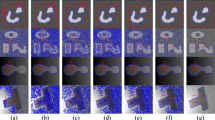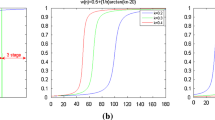Abstract
Traditional level set-based image segmentation method has to solve the level set evolution equation which is the Euler–Lagrange equation of the energy functional defined on the image domain. Solving level set evolution equation is very time-consuming, and reinitialization is usually needed. The level set evolution equation can also be solved by mathematical morphology. The morphological implementation is very simple, fast and stable. The piecewise constant active contour model incorporated with the geodesic edge term is a hybrid active contour model which combines two active contour models which are active contour model without edges and geodesic active contour model. In this paper, the mathematical morphology-based level set evolution method is applied to the piecewise constant active contour model incorporated with the geodesic edge term. The curvature morphological operator is also improved. Experimental results show that, compared with the original piecewise constant active contour model incorporated the geodesic edge term, the new mathematical morphology-based model can segment images more accurately and there are significant gains in simplicity, speed and stability. The new mathematical morphology-based model is also compared to morphological piecewise constant active contour model, morphological geodesic active contour model, traditional piecewise constant active contour model and two other active contour models. Results show that the proposed method gets the segmentation result with faster speed and higher accuracy.






















Similar content being viewed by others
References
Otsu, N.: A threshold selection method from gray-level histograms. IEEE Trans. Syst., Man, Cybern. 9(1), 62–66 (1979)
Pal, N.R.: On minimum cross-entropy thresholding. Pattern Recogn. 29(4), 575–580 (1996)
Mumford, D., Shah, J.: Optimal approximations of piecewise smooth functions and associated variational problems. Commum. Pure Appl. Math. 42, 577–685 (1989)
Kass, M., Witkin, A., Terzopoulos, D.: Snakes: active contour models. Int. J. Comput. Vis. 1, 321–331 (1988)
Caselles, V., Kimmel, R., Sapiro, G.: Geodesic active contours. Int. J. Comput. Vis. 22(1), 61–79 (1997)
Paragios, N., Deriche, R.: Geodesic active contours and level sets for the detection and tracking of moving objects. IEEE T. Pattern Anal. 22(3), 266–280 (2000)
Paragios, N., Deriche, R.: Geodesic active regions and level set methods for supervised texture segmentation. Int. J. Comput. Vis. 46(3), 223–247 (2002)
Paragios, N., Deriche, R.: Geodesic active regions: a new framework to deal with frame partition problems in computer vision. J. Vis. Commun. Image R. 13(1–2), 249–268 (2002)
Vasilevskiy, A., Siddiqi, K.: Flux maximizing geometric flows. IEEE T. Pattern Anal. 24(12), 1565–1578 (2002)
Xie, X., Mirmehdi, M.: MAC: magnetostatic active contour model. IEEE T. Pattern Anal. 30(4), 632–646 (2008)
Chan, T.F., Vese, L.A.: Active contours without edges. IEEE T. Image Process. 10(2), 266–277 (2001)
Chan, T.F., Sandberg, B.Y., Vese, L.A.: Active contours without edges for vector-valued images. J. Vis. Commun. Image R. 11(2), 130–141 (2000)
Li, C., Kao, C., Gore, J.C., Ding, Z.: Minimization of region-scalable fitting energy for image segmentation. IEEE T. Image Process. 17(10), 1940–1949 (2008)
Li, C., Huang, R., Ding, Z., Gatenby, J.C., Metaxas, D.N., Gore, J.C.: A level set method for image segmentation in the presence of intensity inhomogeneities with application to MRI. IEEE T. Image Process. 20(7), 2007–2016 (2011)
Bresson, X., Esedoglu, S., Vandergheynst, P., Thiran, J.P., Osher, S.: Fast global minimization of the active contour/snake model. J. Math. Imaging Vis. 28, 151–167 (2007)
Catte, F., Dibos, F., Koepfler, G.: A morphological scheme for mean curvature motion and applications to anisotropic diffusion and motion of level sets. SIAM J. Numer. Anal. 32(6), 1895–1909 (1995)
Neila, P.M., Baumela, L., Alvarez, L.: A morphological approach to curvature-based evolution of curves and surfaces. IEEE T. Pattern Anal. 36(1), 2–17 (2014)
van den Boomgaard, R., Smeulders, A.: The morphological structure of images: the differential equations of morphological scale-space. IEEE T. Pattern Anal. 16(11), 1101–1113 (1994)
Estellers, V., Zosso, D., Bresson, X., Thiran, J.P.: Harmonic active contours. IEEE T. Image Process. 23(1), 69–82 (2014)
Kim, W., Kim, C.: Active contours driven by the salient edge energy model. IEEE T. Image Process. 22(4), 1667–1673 (2013)
Song, Y., Wu, Y., Bi, S.: Satellite remote sensing cloud image segmentation using edge corrected CV model. Acta Opt. Sin. 34(9) (2014) 0901004-1-8
Perona, P., Malik, J.: Scale-space and edge detection using anisotropic diffusion. IEEE T. Pattern. Anal. 12(7), 629–639 (1990)
Weickert, J., Romeny, B.M.T.H., Viergever, M.A.: Efficient and reliable schemes for nonlinear diffusion filtering. IEEE T. Image Process. 7(3), 398–410 (1998)
Acknowledgements
This work is partially supported by the Yellow River Sediment Key Laboratory of Ministry of Water Resources under Grant 2014006; the Key Laboratory of Rivers and Lakes Governance and Flood Protection of Yangtse River Water Conservancy Committee under Grant CKWV2013225/KY; and the State Key Laboratory of Urban Water Resource and Environment under Grant ES201409.
Author information
Authors and Affiliations
Corresponding author
Additional information
Publisher's Note
Springer Nature remains neutral with regard to jurisdictional claims in published maps and institutional affiliations.
Rights and permissions
About this article
Cite this article
Yu, S., Yiquan, W. A morphological approach to piecewise constant active contour model incorporated with the geodesic edge term. Machine Vision and Applications 31, 28 (2020). https://doi.org/10.1007/s00138-020-01083-4
Received:
Revised:
Accepted:
Published:
DOI: https://doi.org/10.1007/s00138-020-01083-4




